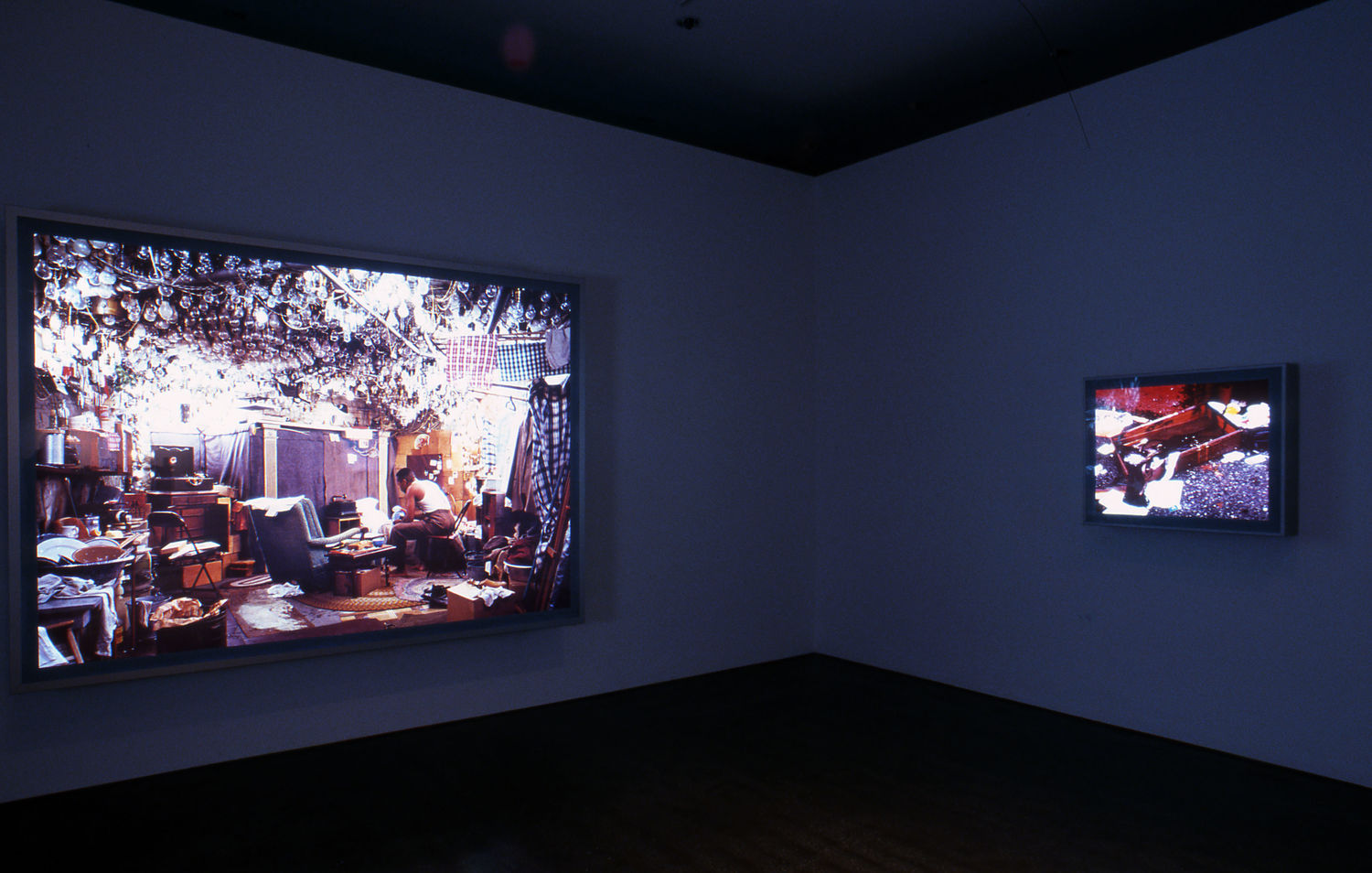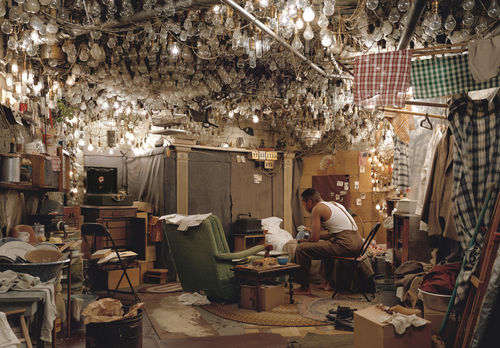
Hammer Projects: Jeff Wall
- – This is a past exhibition
The Hammer Museum presents a group of new works by the internationally acclaimed Canadian artist Jeff Wall. Wall’s work of the past twenty-five years consists primarily of large-scale, color transparencies mounted in lightboxes, and, since 1995, black and white photographs. His pictures resemble both paintings and film stills, drawing the viewer into highly specific scenes that imply larger narratives.
First shown at Documenta 11, After "Invisible Man” by Ralph Ellison, the Preface, 1999-2001, represents a well-known scene from Ellison’s classic novel. Wall’s version shows us the cellar room, “warm and full of light” in which Ellison’s narrator lives, complete with its 1,369 lightbulbs. Energy and light, stolen from the electric company, illuminate not only the character’s basement dwelling, but also the truth of his existence. He tells us, “Light confirms my reality, gives birth to my form…. Without light I am not only invisible but formless as well; and to be unaware of one’s form is to live a death…. The truth is the light and light is the truth.”
This large work is accompanied by a selection of smaller pictures without figures, including Rainfilled Suitcase, 2001. These pictures, which are straight photographs, complement the “cinematography” of the larger piece, and give a sense of the different aspects of Wall’s work.
This exhibition was organized by Russell Ferguson, chief curator.
Biography
Jeff Wall was born in 1946 in Vancouver, where he currently lives and works. His one-person exhibitions include Jeff Wall: Figures and Places at the Museum für moderne Kunst, Frankfurt (2001), Jeff Wall: Oeuvres, 1990–1998 at the Musée d’Art Contemporain, Montreal (1999), and Jeff Wall at the Museum of Contemporary Art, Los Angeles (1997). His work has also been shown in numerous group exhibitions, including Documenta 11 in Kassel, Germany (2002).

Excerpt From Ralph Ellison's INVISIBLE MAN
The point now is that I found a home—or a hole in the ground, as you will. Now don’t jump to the conclusion that because I call my home a “hole” it is damp and cold like a grave; there are cold holes and warm holes. Mine is a warm hole. And remember, a bear retires to his hole for the winter and lives until spring; then he comes strolling out like the Easter chick breaking from its shell. I say all this to assure you that it is incorrect to assume that, because I’m invisible and live in a hole, I am dead. I am neither dead nor in a state of suspended animation. Call me Jack-the-Bear, for I am in a state of hibernation.
My hole is warm and full of light. Yes, full of light. I doubt if there is a brighter spot in all New York than this hole of mine, and I do not exclude Broadway. Or the Empire State Building on a photographer’s dream night. But that is taking advantage of you. Those two spots are among the darkest of our whole civilization—pardon me, our whole culture (an important distinction, I’ve heard)—which may sound like a hoax, or a contradiction, but that (by contradiction, I mean) is how the world moves: Not like an arrow, but a boomerang. (Beware of those who speak of the spiral of history; they are preparing a boomerang. Keep a steel helmet handy.) I know; I have been boomeranged across my head so much that I now can see the darkness of lightness. And I love light. Perhaps you’ll think it strange that an invisible man should need light, desire light, love light. But maybe it is exactly because I am invisible. Light confirms my reality, gives birth to my form. A beautiful girl once told me of a recurring nightmare in which she lay in the center of a large dark room and felt her face expand until it filled the whole room, becoming a formless mass while her eyes ran in bilious jelly up the chimney. And so it is with me. Without light I am not only invisible, but formless as well; and to be unaware of one’s form is to live a death. I myself, after existing some twenty years, did not become alive until I discovered my invisibility.
That is why I fight my battle with Monopolated Light & Power. The deeper reason, I mean: It allows me to feel my vital aliveness. I also fight them for taking so much of my money before I learned to protect myself. In my hole in the basement there are exactly 1,369 lights. I’ve wired the entire ceiling, every inch of it. And not with fluorescent bulbs, but with the older, more-expensive-to-operate kind, the filament type. An act of sabotage, you know. I’ve already begun to wire the wall. A junk man I know, a man of vision, has supplied me with wire and sockets. Nothing, storm or flood, must get in the way of our need for light and ever more and brighter light. The truth is the light and light is the truth. When I finish all four walls, then I’ll start on the floor. Just how that will go, I don’t know. Yet when you have lived invisible as long as I have you develop a certain ingenuity. I’ll solve the problem. And maybe I’ll invent a gadget to place my coffee pot on the fire while I lie in bed, and even invent a gadget to warm my bed—like the fellow I saw in one of those picture magazines who made himself a gadget to warm his shoes! Though invisible, I am in the great American tradition of tinkers. That makes me kin to Ford, Edison and Franklin. Call me, since I have a theory and a concept, a “thinker-tinker.” Yes, I’ll warm my shoes; they need it, they’re usually full of holes. I’ll do that and more.
From Ralph Ellison, Invisible Man (1952). New York: Random House, 1982, pp. 5–6. Reprinted by permission of the publisher.
Hammer Projects are made possible with support from The Horace W. Goldsmith Foundation, The Annenberg Foundation, the Los Angeles County Arts Commission and members of the Hammer Circle.





